There are 19 paintings of Claude Monet in the Dutch museums.
| W-number | English title (Wildenstein catalogue) | Year | Museum | City |
|---|---|---|---|---|
| W23 | By the sea | 1864 | Van Gogh Museum | Amsterdam |
| W83 | Quai du Louvre | 1867 | Haags Gemeentemuseum | The Hague |
| W175 | The Voorzaan | 1871 | Zaans Museum | Zaandam |
| W181 | Windmills near Zaandam | 1871 | Van Gogh Museum | Amsterdam |
| W192 | Portrait of Guurtje van de Stadt | 1871 | Kröller-Müller Museum | Otterlo |
| W304 | Amsterdam | 1874 | Van Gogh Museum | Amsterdam |
| W323 | The Studio Boat | 1874 | Kröller-Müller Museum | Otterlo |
| W477 | The Seine near Vétheuil | 1878 | Museum Boymans-Van Beuningen | Rotterdam |
| W579 | Springtime in Vétheuil | 1880 | Museum Boymans-Van Beuningen | Rotterdam |
| W677 | Poppy Field | 1881 | Museum Boymans-Van Beuningen | Rotterdam |
| W732 | The Fisherman's House, at Varengeville | 1882 | Museum Boymans-Van Beuningen | Rotterdam |
| W768 | Fishing Nets at Pourville | 1882 | Haags Gemeentemuseum | The Hague |
| W788 | Cliffs near Pourville | 1882 | Rijksmuseum Twenthe | Enschede |
| W848 | Vase of Poppies | 1883 | Museum Boymans-Van Beuningen | Rotterdam |
| W890 | The Coastal Road to Monaco | 1884 | Rijksmuseum | Amsterdam |
| W1068 | Field of Flowers and Windmills near Leiden | 1886 | Stedelijk Museum | Amsterdam |
| W1908 | Wisteria | 1919-1920 | Haags Gemeentemuseum | The Hague |
| W1959 | The House Seen Through the Roses | 1925-1926 | Stedelijk Museum | Amsterdam |
| W???? | Flowers | unknown | Rijksmuseum | Amsterdam |
To watch a documentairy about the paintings of Claude Monet in the Dutch museums, click here.
(back to top)
By the sea
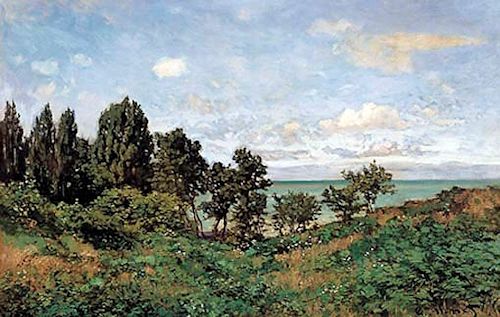 Museum: Van Gogh Museum, Amsterdam
Museum: Van Gogh Museum, Amsterdam
Museum title: By The Sea
Oil on canvas, h 53 cm × w 80 cm.
Go to the museum site
What we see:
Monets coast scene was probably taken near Honfleur. Monet painted the sea from a high point. In the foreground you can see trees and shrubs. The sun shines through it.
History:
Purchased in November 1996 as a parting gift for the outgoing director Ronald de Leeuw.
Quai du Louvre
 Museum: Haags Gemeentemuseum, The Hague
Museum: Haags Gemeentemuseum, The Hague
Museum title: Quai du Louvre
Oil on canvas, h 65 cm × w 92 cm.
Go to the museum site
What we see:
Painted in the spring of 1867, from the colonnade of the Louvre.
On the left, in the middle distance, there is the Pont-Neuf, the tip of the Île de la Cité and the statue of Henri IV,
in the background, aligned from left to right, the spires of Saint-Etienne-du-Mont and the former abbey of Sainte-Geneviève,
the dome of the Pantheon and that of the Val-de-Grâce.
History:
Bequeathed in 1942 to the museum by G.I.F. Philips and J.P. Philips - van der Willigen.
The Voorzaan
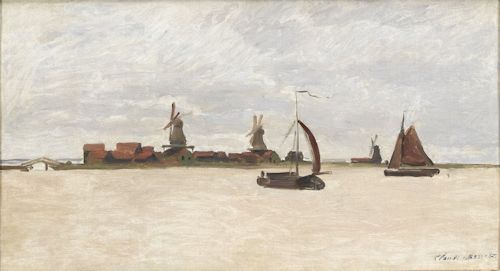 Museum: Zaans Museum
Museum: Zaans Museum
Museum title: De Voorzaan en De Westerhem
Oil on canvas, h 39 cm × w 71 cm.
Go to the museum site
What we see:
This painting is one of a series of three works by Monet's views on the Voorzaan
and the island De Westerhem on which saw mills sawed wood and beams.
The mills are from left to right: "De Bakker" of the firm Van de Stadt, "De Roode Leeuw" and "De Notenboom" of the firm Grass.
The mills disappeared between 1878 and 1916. The island is now a residential area called Zaaneiland.
History:
Purchased in 2015 for € 1,160,000 by the Rembrandt Vereniging, with financial help from
Dr. M.J. van Toorn and L. Scholten Stichting, Honig-Laan Fonds, Ir. P.M. Duyvisfonds,
Gemeente Zaanstad, VSBfonds, Koninklijke Ahold, Jacob Heijn Holding BV,
BredeNHofstichting, Rabobank Zaanstreek and Stichting Monet in Zaandam.
Windmills near Zaandam
 Museum: Van Gogh Museum, Amsterdam
Museum: Van Gogh Museum, Amsterdam
Museum title: Molens in het Westzijderveld bij Zaandam
Oil on canvas, h 48,5 cm × w 74,2 cm.
Go to the museum site
What we see:
The Van Gogh Museum's Mills at Westzijderveld counts as one of the more daring of the Zaandam pictures.
It is one of a small group of works painted in Westzijderveld which, as the name implies,
is an area to the west of the town, a polder landscape criss-crossed with ditches and canals and dotted with an
abundance of windmills and their outbuildings. This area still retains something of its original character
although the precise location painted by Monet can no longer be identified with any certainty.
The artist did, however, render sufficient detail to be able to identify all but the mill second from the left
as so-called smock windmills (bovenkruiers). In this region they were in use mainly as sawmills,
the top half of the structure being swivelled to optimise the angle of the sails to the wind.
In the painting the sails are depicted in the typical summer colours of orange and white,
this last gradually discolouring in the wind and rain to become the murky grey Monet has recorded.
In late October the sails were changed to their traditional winter colours of yellow and brown.
The foreground of the painting is dominated by the view along a wide ditch brimming with water and
crossed by a series of wooden footbridges. Behind the mills, blocks of grey cloud mask the sunlight
in a subtle contre-jour effect. Monet uses combinations of sombre greens, greys and mauves to evoke
an overcast day under a water-laden Dutch sky, an effect that serves to heighten the dramatic
orange-red of the windmill sails. As with many of the Zaandam pictures the viewpoint suggests the artist
was working from a boat, and the swift handling suggests that all or most of the work was executed on the spot.
As Ronald Pickvance has observed, this is "one of Monet's most direct and confident paintings of Zaandam".
In many areas of the picture he applied his paint with fluid, block-like strokes, using the square-ended
brushes that he favoured in the early 1870s. By contrast the rippling water is depicted with simple,
almost child-like scribbles, which seem to be unique to this picture. Traces of an earlier composition
are still visible beneath the present work. It is possible that Monet painted over an earlier work,
although x-radiographs give no indication of what this might have been.
(Source: Van Gogh Museum Journal 2001)
History:
The first known owner of this painting was the German painter Max Liebermann.
Purchased in 2001 by the Van Gogh Museum through Hirschl and Adler Galleries (New York)
with funds provided by the Dutch Sponsor Lottery, the Stichting Nationaal Fonds Kunstbezit,
the Vereniging Rembrandt, supported by the Prins Bernhard Cultuurfonds and a donation from VNU,
the Ministry of Education Culture and Science; the Mondrian Foundation, the VSB Fonds
and the Vincent van Gogh Foundation (2001). The donation from the Stichting Nationaal Fonds Kunstbezit
was made possible with contributions from Philips Electronics, Shell, Unilever, ABN AMRO, ING, Fortis and Heineken.
Portrait of Guurtje van de Stadt
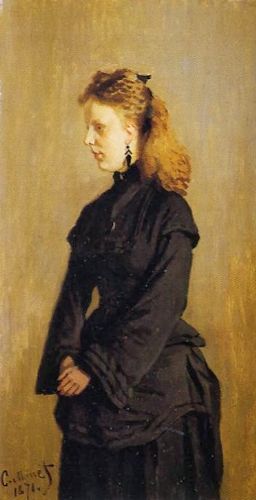 Museum: Kröller-Müller Museum, Otterlo
Museum: Kröller-Müller Museum, Otterlo
Museum title: Portret van mej. Guurtje van de Stadt
Oil on canvas, h 72,2 cm × w 40 cm.
Go to the museum site
What we see:
In 1871 Claude Monet was staying for four months in Zaandam.
It was told that his wife Camille was giving French conversation lessons to make some income.
Guurtje was presumably one of the pupils, being the daugther of the wealthy Jan van der Stadt, who was in the timber trade and died in April 1871.
Guurtje is still wearing her mourning clothes on his portrait.
History:
The portrait was owned by the model herself, who became Mrs. G.E.G. Duyvis on marriage and died in 1936.
Bequeathed by Mrs. G.E.G. van Giffen-Duyvis in 1984 to the Kröller-Müller Museum in Otterlo.
Amsterdam
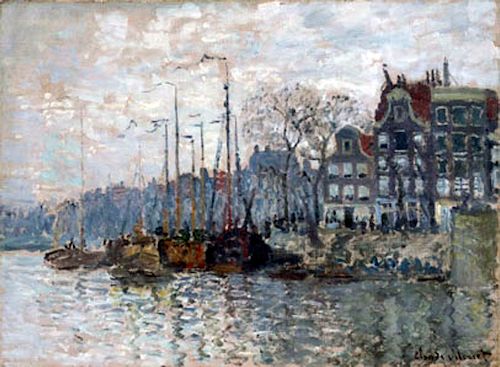 Museum: Van Gogh Museum, Amsterdam
Museum: Van Gogh Museum, Amsterdam
Museum title: Gezicht op de Prins Hendrikkade en de Kromme Waal in Amsterdam
Oil on canvas, h 50,2 cm × w 68,5 cm.
Go to the museum site
What we see:
The View of the Prins Hendrikkade and the Kromme Waal in Amsterdam must have been painted from a boat.
The subject is located not far from the city's central railway station. The houses at the right stand on what is now called
Prins Hendrikkade (before 1879 known as Kamperhoofd). The buildings, though somewhat altered, are still recognisable today.
The boats to the left are moored in Waalseilandsgracht, while in the distance Monet has shown parts of Kromme and Oude Waal,
which lead towards the centre of the city. A larger painting now in the Rau Foundation collection shows the same group of
buildings but from around the corner. It seems that Monet may have manipulated the scenery to suit his own compositional ends.
A drawing by Carel Storm van 's-Gravensande, showing much the same view as the Van Gogh Museum's picture, clearly records a
bridge over Waalseilandsgracht that Monet seems to have edited out.
It also seems that the bridge pier at the right of Monet's painting was not actually visible from this vantage point.
Perhaps Monet felt the need for a feature here to add interest to the foreground.
In technique the view of Amsterdam is quite different from the earlier vista of Zaandam.
If in the terms familiar to the impressionists the latter could be described as an étude (a finished picture painted
directly from nature), then the View of the Prins Hendrikkade is a pochade, i.e. a rapid and freely painted sketch.
By 1874 Monet was using a variety of different brushstrokes to bring his subjects to life.
Here, soft dabs of paint recreate the characteristic canal-side buildings of Amsterdam; small, nervous touches define
the skimpy, leafless trees, while longer trails of liquid paint are used to capture the flickering reflections in the water.
Monet began by laying in both sky and water with a base colour of pinkish grey. This colour and the grey priming layer are
left exposed throughout the picture, acting as a unifying element in the colour scheme. The arrangement of the composition
has a simplicity verging on artlessness. The real interest in the picture lies in the rendering of light and atmosphere.
The artist's muted colours and delicate handling conspire to evoke the subtle, watery light of Amsterdam, tempered by a
play of ever-changing reflections. (Source: Van Gogh Museum Journal 2001)
History:
Purchased in 2001 by the Van Gogh Museum with funds provided by the Dutch Sponsor Lottery, the Stichting Nationaal Fonds Kunstbezit,
the Vereniging Rembrandt, supported by the Prins Bernhard Cultuurfonds and a donation from VNU,
the Ministry of Education Culture and Science; the Mondrian Foundation, the VSB Fonds and the Vincent van Gogh Foundation (2001).
The donation from the Stichting Nationaal Fonds Kunstbezit was made possible with contributions from Philips Electronics, Shell,
Unilever, ABN AMRO, ING, Fortis and Heineken.
The Studio Boat
 Museum: Kröller-Müller Museum, Otterlo
Museum: Kröller-Müller Museum, Otterlo
Museum title: Monet's studio boat
Oil on canvas, h 50,2 cm × w 65,5 cm.
Go to the museum site
What we see:
"The inspiration of the studio boat is very likely from Charles-François Daubigny,
the French painter associated with the Barbizon School who is well known for his “innovative landscapes”.
Monet had association with Daubigny in London in the early 1870s, prior to the launch of Monet’s studio boat.
Daubigny built his boat, which is identical to Monet’s, in 1857.
While Daubigny would travel for days on the Oise and Seine painting,
Monet “seems to have moored his where he was living, using it only within a short radius of home”.
Even though Monet’s studio boat has hardly gone far away from home,
it is nevertheless Monet’s pathway to the freedom of water, where his studio boat can “float along with quiet
backwaters of an isolated stretch of the river nestled between thickly foliated banks”.
It is in such place that Monet can be with himself,
“be completely alone, contemplating the beauties of undisturbed nature much like his Barbizon predecessors”.
This solitude Monet enjoys in his studio boat is well presented in the painting The Studio Boat."
(Source: Monet’s Studio Boat and His Internal Freedom )
History:
Bought in 1915 by Helene Kröller-Müller. In 1938 her collection entered the Kröller-Müller Museum in Otterlo.
More about Impressionism and the use of a studio boat: Connected: Rigging a studio boat
The Seine near Vétheuil
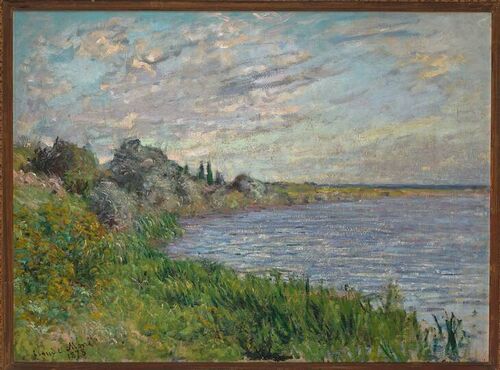 Museum: Museum Boijmans Van Beuningen, Rotterdam
Museum: Museum Boijmans Van Beuningen, Rotterdam
Museum title: La Seine près de Vétheuil (De Seine bij Vétheuil)
Oil on canvas, h 62 cm × w 83 cm.
Go to the museum site
What we see:
In 1878, Claude Monet settled in the village of Vétheuil, a small village about seventy kilometers northwest of Paris.
The paintings from Vétheuil show a radical change in Monet's work. From busy city scenes he moved toward the desolate landscape.
He became increasingly fascinated by the effects of light and color, which came about by the ever-changing weather.
The painting shows the Seine south of Vétheuil, looking upstream.
History:
Acquired with the collection of D.G. van Beuningen 1958.
Springtime in Vétheuil
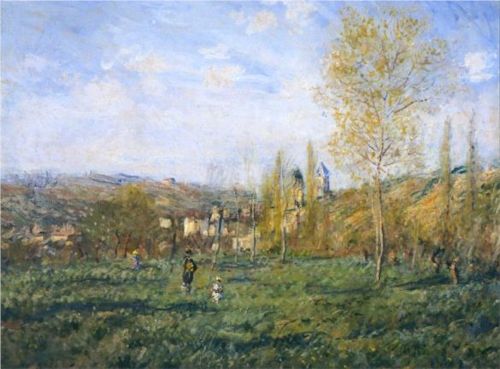 Museum: Museum Boijmans Van Beuningen, Rotterdam
Museum: Museum Boijmans Van Beuningen, Rotterdam
Museum title: Printemps à Vétheuil (Lente in Vétheuil)
Oil on canvas, h 60,5 cm × w 80,5 cm.
Go to the museum site
What we see:
Shows a meadow on the largest Moisson island, with Vétheuil in the background;
seen from this angle, the belltower of the church is to the left of the villa
known as "Les Tourelles".
To capture color and light in nature as directly as possible, Monet often painted outdoors.
To catch a certain moment in the ever-changing nature, he had to work quickly.
This painting was created in a hurry.
He gives an apparently literal impression of a spring day.
History:
Loan: Stichting Museum Boijmans Van Beuningen 1951.
Poppy Field
 Museum: Museum Boijmans Van Beuningen, Rotterdam
Museum: Museum Boijmans Van Beuningen, Rotterdam
Museum title: Champ de coquelicots (Papaverveld)
Oil on canvas, h 58 cm × w 79 cm.
Go to the museum site
What we see:
Painted in the Plain of Lavacourt, on the other side of the Seine from Vétheuil.
History:
Acquired with the collection of: D.G. van Beuningen 1958
The Fisherman's House, at Varengeville
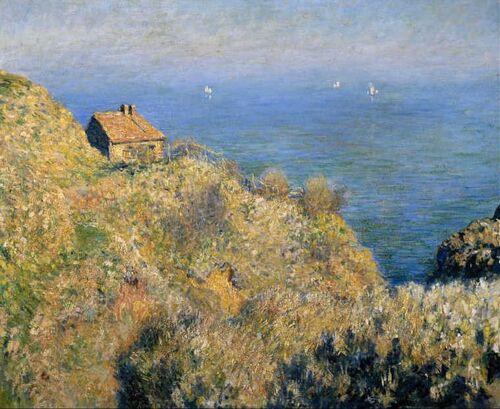 Museum: Museum Boijmans Van Beuningen, Rotterdam
Museum: Museum Boijmans Van Beuningen, Rotterdam
Museum title: La maison du pêcheur, Varengeville (De hut van de visser, Varengeville)
Oil on canvas, h 60 cm × w 78 cm.
Go to the museum site
What we see:
These little cottages were occupied by customs officers who kept watch over the Channel Coast
and were built on the orders of Napoléon during the Continental Blockade.
The cottage at Le Petit Ailly - almost halfway between the beach at Pourville and the church of
Varengeville - was one of Monet's favourite subjects. The cottage is seen from the opposite side
of the cleft in the cliff.
The name "cabane des douaniers" (customs officer's hut) was often changed by Monet himself,
when a painting was being sold, to "maison du pêcheur" (fisherman's house) although this was
the same building which was occupied by fishermen once it was no longer used by the customs
officers of Napoléon's empire.
The cottage became derelict and the roof fell in around 1942.
The foundations eroded and it finally fell from the cliff on to the beach some 70 feet below
in the 1950s.
History:
Acquired in 1928 through the J.P. van der Schilden Fonds by the museum.
Fishing Nets at Pourville
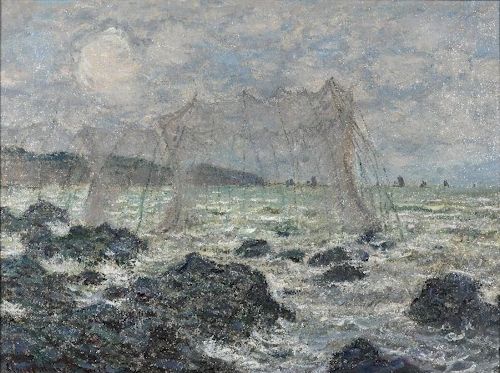 Museum: Haags Gemeentemuseum, The Hague
Museum: Haags Gemeentemuseum, The Hague
Museum title: De netten van Pourville
Oil on canvas, h 60 cm × w 81 cm.
Go to the museum site
What we see:
The fishermen of Pourville were in the habit of hitching their nets to stakes planted
in the sea close to the shore. Fish would get caught in them at high tide and could be
collected when the sea receded.
History:
Acquired by the museum at the sale Jules Strauss, Paris, Georges Petit, 15 December 1932.
Cliffs near Pourville
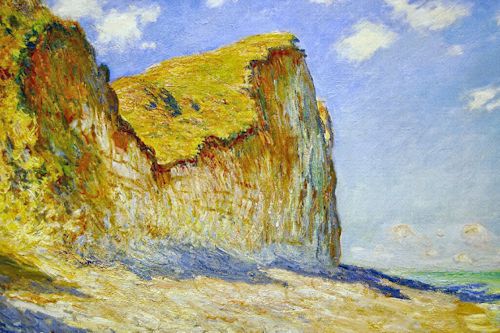 Museum: Rijksmuseum Twenthe, Enschede
Museum: Rijksmuseum Twenthe, Enschede
Museum title: Falaises près de Pourville
Oil on canvas, h 60,4 cm × w 80,9 cm.
Go to the museum site
What we see:
This painting was created during Monet’s stay in the village of Pourville in the summer of 1882.
The attention of the viewer is immediately drawn to the impressive, sheer chalk cliff and the
yellowish glow of the vegetation in the bright morning sun. Where the yellow surface borders
the contrasting blue sky, the luminosity of the colours is even more accentuated. Monet’s
striving to register the variations in light can primarily be observed through the dark
shadows that the rocks cast on the beach. The dark blue of the surf reveals that the
shadow of the cliff wall was initially longer and that the shadows cast by the rocks
are now creeping towards the foot of the cliff in the rising sun.
History:
Last owner before the museum: Mr. N.H. van Heck, Enschede.
Vase of Poppies
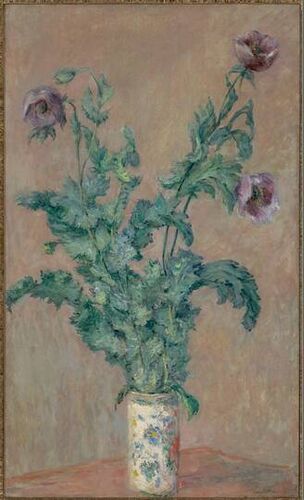 Museum: Museum Boijmans Van Beuningen, Rotterdam
Museum: Museum Boijmans Van Beuningen, Rotterdam
Museum title: Vase de pavots (Vaas met papavers)
Oil on canvas, h 98 cm × w 60 cm.
Go to the museum site
What we see:
One of two paintings of this vase with flowers, probably painted in the summer of 1883.
The same kind of flowers were painted on some door panels for Durand-Ruel's Drawing Room.
History:
Loan: Stichting Willem van der Vorm 1972
The Coastal Road to Monaco
 Museum: Rijksmuseum, Amsterdam
Museum: Rijksmuseum, Amsterdam
Museum title: La Corniche near Monaco
Oil on canvas, h 75 cm × w 94 cm.
Go to the museum site
What we see:
In Monet’s time La Corniche was a narrow mountain track; nowadays,
it is the main road between Nice and Monaco. Here the sun is high,
the lone walker’s shadow short. Monet’s colours glisten: red, green,
blue – everything shimmers in the sunlight. The painting was given
to the Rijksmuseum already in 1900, when Monet’s work was still
entirely unknown in the Netherlands.
History:
Gift of M.C. Baroness van Lynden-van Pallandt, The Hague, April 1900
Field of Flowers and Windmills near Leiden
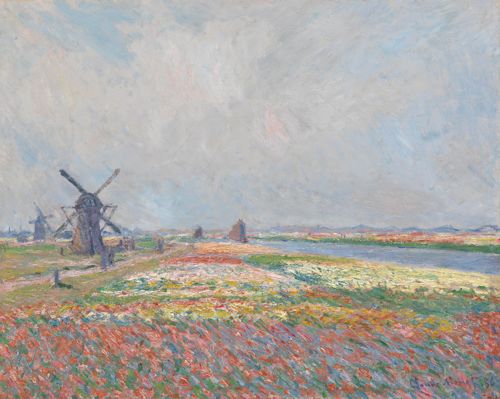 Museum: Van Gogh Museum, Amsterdam
Museum: Van Gogh Museum, Amsterdam
Museum title: Tulpenvelden vlak bij Den Haag
Oil on canvas, h 66 cm × w 81,5 cm.
Go to the museum site
What we see:
In 1886 the French painter Claude Monet spent ten days in the Netherlands.
He was delighted by the Dutch landscape with windmills and tulip fields and
made five paintings. This painting was sold the same year by art dealer
Theo van Gogh. It is therefore quite possible that his brother Vincent
has seen the painting.
The dunes can be seen stabbing against the sky. The Almondeweg and the mill
"Hoop doet leven" (Hope springs eternal), close to the Oegstgeester Channel,
still exist and can be seen from the main road between Amsterdam and The Hague.
The second mill, Butterfly, was demolished in the 30s.
History:
Loan: Rijksdienst Beeldende Kunst, Den Haag
Wisteria
 Museum: Haags Gemeentemuseum, The Hague
Museum: Haags Gemeentemuseum, The Hague
Museum title: Blauwe regen
Oil on canvas, h 153,6 cm × w 203,5 cm.
Go to the museum site
What we see:
The subject of wisteria had its origin in the garden in Giverny. In 1910 Monet enlarged the pond and built
a canopy over the arched, Japanese-style bridge that straddled its narrow western end.
The bridge and canopy soon became the supports for white and lilac wisteria imported
from China and Japan. Monet translated these rising arcs of flowers into heavy, looping festoons.
History:
Acquired in 1961 by the museum from Beyeler, Basel.
The House Seen Through the Roses
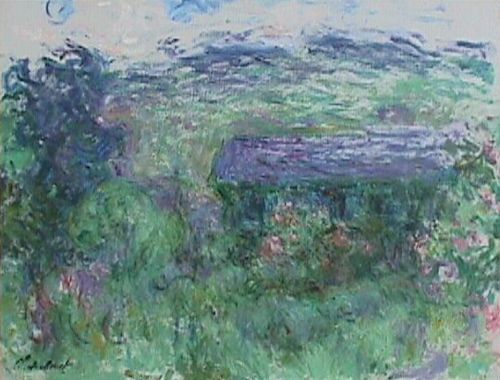 Museum: Stedelijk Museum, Amsterdam
Museum: Stedelijk Museum, Amsterdam
Museum title: La maison à travers les roses
Oil on canvas, h 66 cm × w 82 cm.
Go to the museum site
What we see:
This painting is part of a series of four works with the same title.
It shows the west facing side of the house with the artist's bedroom whose window can
be seen above the studio drawing room. The top of the canvas is partially unpainted.
It is unclear whether this was Monet's intention, or that it is an unfinished work.
After Monet's death La maison à travers les roses was found in his studio.
History:
Acquired in 1959 by the museum from Beyeler, Basel.
Flowers
 Museum: Rijksmuseum Amsterdam
Museum: Rijksmuseum Amsterdam
Museum title: Bloemen (Unknown in Monet literature)
Oil on panel, h 91 cm × w 48 cm.
Go to the museum site
What we see:
Flowers. Undated and there is no other Monet painting of the same size. The painting could be associated with the wooden panels
for Durand-Ruel in 1882-1883.
History:
Andries van Wezel (1856-1921) was a jewish diamond worker who began to earn a lot of money.
At a certain moment he could afford a house in the wealthy Sarphatistraat in Amsterdam, also known as the Broad Jewsstreet.
He opened his house to artists and for some of them he was a true benefactor: he bought their work and even gave allowances.
In his collection he included Breitner, Monet, Daubigny, Isaac and Jozef Israels.
At his death in 1921 Van Wezel bequeathed 150 works that were in his possession to the Amsterdam Rijksmuseum.
Entrence in the museum in april 1922.
Source: "Verzamelaars met lef (Collectors with guts)", Hans Masselink, Trouw, 16-03-2010.